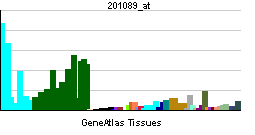ATP6V1B2
| ATPase, H+ transporting, lysosomal 56/58kDa, V1 subunit B2 | |||||||||||
|---|---|---|---|---|---|---|---|---|---|---|---|
| Identifiers | |||||||||||
| Symbols | ATP6V1B2 ; VATB; VPP3; ATP6B1B2; ATP6B2; HO57; Vma2 | ||||||||||
| External IDs | Template:OMIM5 Template:MGI HomoloGene: 1279 | ||||||||||
| |||||||||||
| RNA expression pattern | |||||||||||
 | |||||||||||
| More reference expression data | |||||||||||
| Orthologs | |||||||||||
| Template:GNF Ortholog box | |||||||||||
| Species | Human | Mouse | |||||||||
| Entrez | n/a | n/a | |||||||||
| Ensembl | n/a | n/a | |||||||||
| UniProt | n/a | n/a | |||||||||
| RefSeq (mRNA) | n/a | n/a | |||||||||
| RefSeq (protein) | n/a | n/a | |||||||||
| Location (UCSC) | n/a | n/a | |||||||||
| PubMed search | n/a | n/a | |||||||||
ATPase, H+ transporting, lysosomal 56/58kDa, V1 subunit B2, also known as ATP6V1B2, is a human gene.[1]
This gene encodes a component of vacuolar ATPase (V-ATPase), a multisubunit enzyme that mediates acidification of eukaryotic intracellular organelles. V-ATPase dependent organelle acidification is necessary for such intracellular processes as protein sorting, zymogen activation, receptor-mediated endocytosis, and synaptic vesicle proton gradient generation. V-ATPase is composed of a cytosolic V1 domain and a transmembrane V0 domain. The V1 domain consists of three A, three B, and two G subunits, as well as a C, D, E, F, and H subunit. The V1 domain contains the ATP catalytic site. The protein encoded by this gene is one of two V1 domain B subunit isoforms and is the only B isoform highly expressed in osteoclasts.[1]
References
Further reading
- Finbow ME, Harrison MA (1997). "The vacuolar H+-ATPase: a universal proton pump of eukaryotes". Biochem. J. 324 ( Pt 3): 697–712. PMID 9210392.
- Stevens TH, Forgac M (1998). "Structure, function and regulation of the vacuolar (H+)-ATPase". Annu. Rev. Cell Dev. Biol. 13: 779–808. doi:10.1146/annurev.cellbio.13.1.779. PMID 9442887.
- Nelson N, Harvey WR (1999). "Vacuolar and plasma membrane proton-adenosinetriphosphatases". Physiol. Rev. 79 (2): 361–85. PMID 10221984.
- Forgac M (1999). "Structure and properties of the vacuolar (H+)-ATPases". J. Biol. Chem. 274 (19): 12951–4. PMID 10224039.
- Kane PM (1999). "Introduction: V-ATPases 1992-1998". J. Bioenerg. Biomembr. 31 (1): 3–5. PMID 10340843.
- Wieczorek H, Brown D, Grinstein S; et al. (1999). "Animal plasma membrane energization by proton-motive V-ATPases". Bioessays. 21 (8): 637–48. doi:10.1002/(SICI)1521-1878(199908)21:8<637::AID-BIES3>3.0.CO;2-W. PMID 10440860.
- Nishi T, Forgac M (2002). "The vacuolar (H+)-ATPases--nature's most versatile proton pumps". Nat. Rev. Mol. Cell Biol. 3 (2): 94–103. doi:10.1038/nrm729. PMID 11836511.
- Kawasaki-Nishi S, Nishi T, Forgac M (2003). "Proton translocation driven by ATP hydrolysis in V-ATPases". FEBS Lett. 545 (1): 76–85. PMID 12788495.
- Morel N (2004). "Neurotransmitter release: the dark side of the vacuolar-H+ATPase". Biol. Cell. 95 (7): 453–7. PMID 14597263.
- Nelson RD, Guo XL, Masood K; et al. (1992). "Selectively amplified expression of an isoform of the vacuolar H(+)-ATPase 56-kilodalton subunit in renal intercalated cells". Proc. Natl. Acad. Sci. U.S.A. 89 (8): 3541–5. PMID 1373501.
- Bernasconi P, Rausch T, Struve I; et al. (1990). "An mRNA from human brain encodes an isoform of the B subunit of the vacuolar H(+)-ATPase". J. Biol. Chem. 265 (29): 17428–31. PMID 2145275.
- Lee BS, Underhill DM, Crane MK, Gluck SL (1995). "Transcriptional regulation of the vacuolar H(+)-ATPase B2 subunit gene in differentiating THP-1 cells". J. Biol. Chem. 270 (13): 7320–9. PMID 7706273.
- van Hille B, Richener H, Schmid P; et al. (1994). "Heterogeneity of vacuolar H(+)-ATPase: differential expression of two human subunit B isoforms". Biochem. J. 303 ( Pt 1): 191–8. PMID 7945239.
| This protein-related article is a stub. You can help Wikipedia by expanding it. |